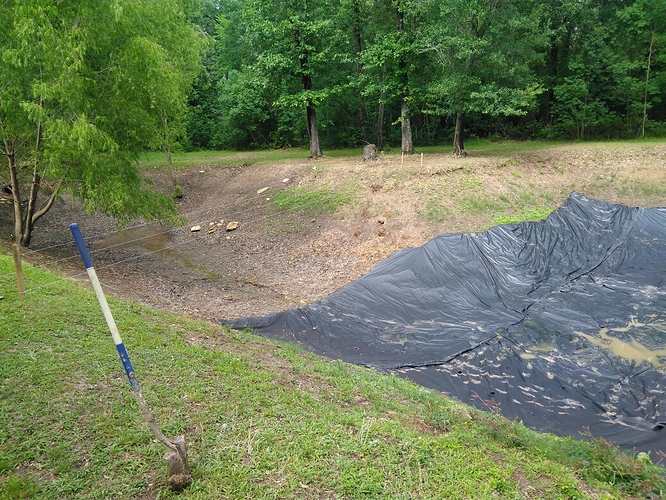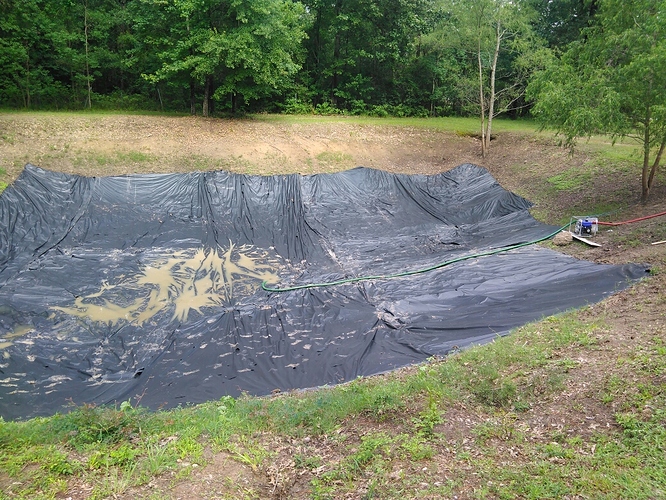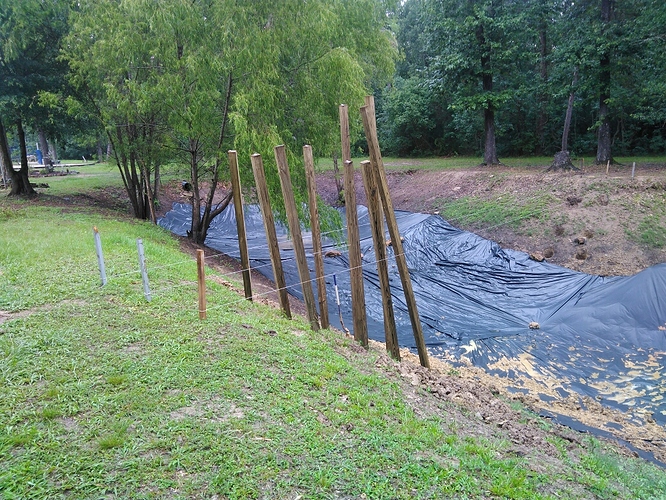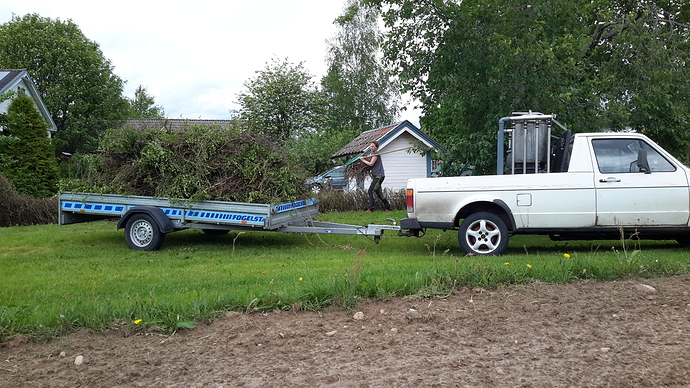Hi Kevin,
We had a couple catfish at the bottom and the birds have tracked in feeder fish from the lake. We have a regular crane that visits and he had a field day the day we got to the bottom. My neighbor also took some over to his pond. We have a bunch of turtles that have all moved over to the little pond. You don’t really want to go swimming with the water snakes and cotton mouths around  I plan on getting some bass and some catfish to stock it when we get it fixed up. (those brats and onions do look good)
I plan on getting some bass and some catfish to stock it when we get it fixed up. (those brats and onions do look good)
When it’s BBQ time here, a quick trip to the Out Door Wood Boiler to fill a steel bucket provides the hot, ready to go , charcoal for the smoker/ grill. Add a few splits of Hickory and Cherry wood for the flavor . Wood only folks ! It’s a way of life.
The water flowing down the Columbia River has been at high water stage, with the extra snow pack in the Canadian mountains and in Washington. The run off will last a little longer this year. Normal river flow is around 130,000 cubic feet per second or less during the rest of the year. We have been seeing over 300,000 cfs. At about 350,000 cfs. It floods the State Park across the river from us. The rivers feeding the Columbia River have been raging and flooding in some parts of Washington. Pretty normal Spring and early Summer conditions for us. Glad we have Dams on the Columbia River to control and regulate the water that is flowing by us.
Bob
That should keep the water from leaking out the bottom and the pond weed from growing where the plastic liner
has been laid down covering the bottom of the pond.
Bob
What is the liner material?
Back 25 years I would hire 15 to 20 folks and place 6 mil reinforced polyethylene sheets 200 x 300 or 1.25 acres each as temporary cover on a 20 acre landfill. PUFF PUFF
a Little wind, on a sunny day and you would get a 50’ high hot air balloon
Be sure to bury the edges 6"
Also that stuff likes to float especially when a few gas bubbles develope so a couple inches of 1" minus clean gravel will keep it protected for 20+ years
Using “plastic” gets a bad rap.
Last year I bought a 6 mil 35’x120’ roll of black poly. Sectioned it off into four pieces to cover the just-in-case next-years piles of butt chunks, pitch-sections and tree tops. The previous black poly sections had lasted re-uesed and re-used out in the PNW weather for 15 years.
Next year I am going the try some clear poly cover on the garden plot to try and get a few weeks jump on the soil warming up temperature. Read this in Experts Book of Garden Hints by an Alton Eliason living in, “The Vermont cold pocket of New England”.
And Elliot Colman in the appendix of his Vermont located “Four Seasons Gardens” makes a very favorable math/cost comparison of can-be-reused for years petroleum made poly versus the cost of truck shipping in winter lettuce heads from California year after year.
And in this same book one gal recommends bottom cutting out plastic milk jugs as plants frost protectors. Remove cap to day-time ventilate. Another expert gal stopped buying commercial Wall’ofWater for her early Atlantic states cold Spring plantings. Uses clear plastic beverage bottles water filled dug-in around her planting and those then single sheet plastic wrapped.
Ha! Cannot stop the wife from her bottled water insistnace. So might as well get a Re-Use out of them before giving them off to BenP for his projects. Giving to the VFW fund raisers.
“Idealism is the enemy of getting others to stop, look and appreciate your DOings” s.u.
Good gettin’er-done JasonMcB
J-I-C Steve Unruh
You’re right about using clear poly for heating the soil. 6 mil is the way to go, beats 4 mil by a mil(e). Black blocks the sun from penetrating the soil and it only heats by conduction, slooooow and shallow. Only drawback, weeeds will grow under clear poly, some will get heat killed, but there’ s always one adam-henry in the crowd! Like the new topic, Steve.
Pepe
Good morning Mr Pepe
In Elliot Colman “Four-Season Harvest” book 1992-99 he attributes the Father of clear plastic greenhousing to Professor Emery Myers Emmert staring in the late 1930’s. Pre-WWII the good professor used cellulose acetate sheeting he got from the same suppliers as the cigarette package manufactures used.
Cellulose acetate is made from wood and plant fibers.
It was after WWII that he switched to a longer chained polyethylene made from Dino-glut as more durable and super cheaper, available, then.
The plastic water bottles I complain that my wife obsesses with versus our now mandated chlorine dosed tap waters are “plant based” Desanie (sp) and OregonRain brands. Theses bottles are made from corn starches.
Post-oil glut world we could still have clear AG sheeting. Eventual bio-degradable would be better anyhow.
FIRST - DO to prove the capability, and learn forward from.
Next - then evolve to get the same results with less inputs, and better sustainable inputs.
Good to hear from 'ya man. You and I will have to keep monkey beating these drums of reasonableness until no longer able, eh. Ain’t quite ready to move on yet. Wifie would kill me for bailing on her, leaving her to do all of the weeding (little joke there).
J-I-C Steve Unruh
We replaced the first cover of our hoophouse almost 2 years ago. The old one went on to become frost covers for the outside beds. I figured if it was to become very expensive we could have stretched out the replacement a few extra years. Once every 7 to 10 years is not too fossil fuel intensive I think.
I would really like to get 7 years out of clear plastic, the sun cooks our plastic brittle and breaks like hard plastic, going to have to try the 6 miles. Thanks for the tip
Bob
I have some big pieces of plastic that came from a farmer who uses plastic bags 8 ft. in diameter to pack silage in, instead of a silo. It is atleast 6 mil, black on one side and white on the other. When I chunk wood, I spread a sheet of plastic out on a slight sloping spot, and dump the chunks on. I keep another piece of plastic near to cover up when it rains. With a week of good weather and the black side up, my would is dry. I bag the wood and roll up the plastic for next time. I have to say after a couple of years of doing this in the same spot I am NOT getting the grass to come back. TomC
Go for the six mil and buy greenhouse plastic not construction. There is a uv protective coating on real greenhouse plastic. Yellowing and brittle tells me it wasn’t there.
Mr JO; Rabbits like “greens” but the VW Rabbit is a different breed. That is too much greens for the VW TomC
I get stuff like that all the time, and usually lay it out in the pasture to dry, and then hit it with the shredder and my diesel tractor. Then later I pick up the branches and feed them into the top of my charcoal making barrels. (Do they use shredders in Sweden?) Here is a photo of one (not mine).
Do you ever throw a bit of charcoal into your hopper on top of the regular fuel?
Yes, shredders are used here as well. Also with chains rotating for clearing ditches and road sides.
I guess I could do that but I don’t collect a lot of char since my gasifier is on the smaller side and runs 110% most of the time. I guess I’m consuming most of it. I collect only maybe a shovel of char every 500 miles or so.
I have tryed this and it works great in terms of gas quality at cold weather. Less chance of freezeing problems in the sistem.





